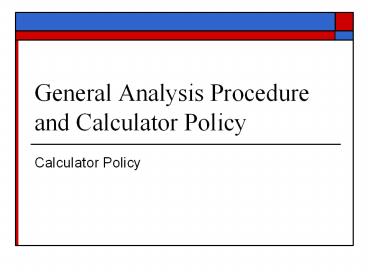General Analysis Procedure and Calculator Policy - PowerPoint PPT Presentation
1 / 10
Title:
General Analysis Procedure and Calculator Policy
Description:
General Analysis Procedure and Calculator Policy Calculator Policy Calculator Policy What is the calculator policy? What calculators may I bring to the exam? – PowerPoint PPT presentation
Number of Views:58
Avg rating:3.0/5.0
Title: General Analysis Procedure and Calculator Policy
1
General Analysis Procedure and Calculator Policy
- Calculator Policy
2
Calculator Policy
- What is the calculator policy? What calculators
may I bring to the exam? - Only models of calculators approved by NCEES are
permitted in the exam room. No other models of
calculators are permitted in the exam room. The
following are the only calculators that will be
permitted in the exam room for the 2010 exam
administrations.
3
Calculator Policy
- Casio All fx-115 models. Any Casio calculator
must contain fx-115 in its model name. Examples
of acceptable Casio fx-115 models include (but
are not limited to) - fx-115 MS
- fx-115 MS Plus
- fx-115 MS SR
- fx-115 ES
- Hewlett Packard The HP 33s and HP 35s models,
but no others.
4
Calculator Policy
- Texas Instruments All TI-30X and TI-36X models.
Any Texas Instruments calculator must contain
either TI-30X or TI-36X in its model name.
Examples of acceptable TI-30X and TI-36X models
include (but are not limited to) - TI-30Xa
- TI-30Xa SOLAR
- TI-30Xa SE
- TI-30XS Multiview
- TI-30X IIB
- TI-30X IIS
- TI-36X II
- TI-36X SOLAR
5
General Analysis Procedure
- The following procedure applies for exams and
homework
6
General Analysis Procedure
- The general analysis procedure consists of the
following seven steps. - Problem Statement The problem statement is a
written description of the analytical problem to
be solved. It should be written clearly,
concisely. and logically. - Diagram The diagram is a sketch. drawing. or
schematic of the system being analyzed.
Typically. it is a simplified pictorial
representation of the actual system, showing only
those aspects of the system that are necessary to
perform the analysis.
7
- Imagine the Flash Light has two lamps.
8
General Analysis Procedure
- Assumptions Engineering analysis almost always
involves some assumptions. Assumptions are
special assertions about the physical
characteristics of the problem that simplify or
refine the analysis. - Governing Equation. All physical systems may be
described by mathematical relations. Governing
equations are those mathematical relations that
specifically pertain to the physical system being
analyzed.
9
General Analysis Procedure
- Calculations In this step. the solution is
generated - First, the solution is developed algebraically
as far as possible. - Then numerical values of known physical
quantities are substituted for the corresponding
algebraic variables. - Solution Check This step is crucial. Immediately
after obtaining the result, examine it carefully.
Using established knowledge of similar analytical
solutions and common sense, try to ascertain
whether the result is reasonable.
10
General Analysis Procedure
- Discussion After the solution has been thoroughly
checked and corrected, discuss the result. - The discussion may include an assessment of the
assumptions, a summary of the main conclusions, a
proposal on how the result may be verified
experimentally in a laboratory, - or a parametric study demonstrating the
sensitivity of the result to a range of input
parameters.































